
Nokia Corporation is a Finnish multinational telecommunications, information technology, and consumer electronics corporation, established in 1865. Nokia's main headquarters are in Espoo, Finland, in the greater Helsinki metropolitan area, but the company's actual roots are in the Tampere region of Pirkanmaa. In 2020, Nokia employed approximately 92,000 people across over 100 countries, did business in more than 130 countries, and reported annual revenues of around €23 billion. Nokia is a public limited company listed on the Helsinki Stock Exchange and New York Stock Exchange. It is the world's 415th-largest company measured by 2016 revenues according to the Fortune Global 500, having peaked at 85th place in 2009. It is a component of the Euro Stoxx 50 stock market index.

A scuba set, originally just scuba, is any breathing apparatus that is entirely carried by an underwater diver and provides the diver with breathing gas at the ambient pressure. Scuba is an anacronym for self-contained underwater breathing apparatus. Although strictly speaking the scuba set is only the diving equipment that is required for providing breathing gas to the diver, general usage includes the harness by which it is carried, and those accessories which are integral parts of the harness and breathing apparatus assembly, such as a jacket or wing style buoyancy compensator and instruments mounted in a combined housing with the pressure gauge, and in the looser sense, it has been used to refer to all the diving equipment used by the scuba diver, though this would more commonly and accurately be termed scuba equipment or scuba gear. Scuba is overwhelmingly the most common underwater breathing system used by recreational divers and is also used in professional diving when it provides advantages, usually of mobility and range, over surface supplied diving systems, and is allowed by the relevant legislation and code of practice.
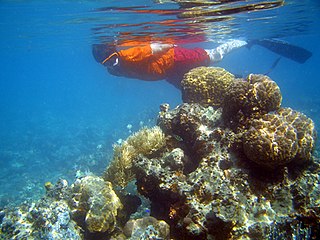
Snorkeling is the practice of swimming on or through a body of water while equipped with a diving mask, a shaped breathing tube called a snorkel, and usually swimfins. In cooler waters, a wetsuit may also be worn. The use of this equipment allows the snorkeler to observe underwater attractions for extended periods with relatively little effort and to breathe while face-down at the surface.

A diving cylinder or diving gas cylinder is a gas cylinder used to store and transport high pressure gas used in diving operations. This may be breathing gas used with a scuba set, in which case the cylinder may also be referred to as a scuba cylinder, scuba tank or diving tank. When used for an emergency gas supply for surface supplied diving or scuba, it may be referred to as a bailout cylinder or bailout bottle. It may also be used for surface-supplied diving or as decompression gas. A diving cylinder may also be used to supply inflation gas for a dry suit or buoyancy compensator. Cylinders provide gas to the diver through the demand valve of a diving regulator or the breathing loop of a diving rebreather.

A diving regulator is a pressure regulator that controls the pressure of breathing gas for diving. The most commonly recognised application is to reduce pressurized breathing gas to ambient pressure and deliver it to the diver, but there are also other types of gas pressure regulator used for diving applications. The gas may be air or one of a variety of specially blended breathing gases. The gas may be supplied from a scuba cylinder carried by the diver or via a hose from a compressor or high-pressure storage cylinders at the surface in surface-supplied diving. A gas pressure regulator has one or more valves in series which reduce pressure from the source, and use the downstream pressure as feedback to control the delivered pressure, or the upstream pressure as feedback to prevent excessive flow rates, lowering the pressure at each stage.

Standard diving dress, also known as hard-hat or copper hat equipment, deep sea diving suit or heavy gear, is a type of diving suit that was formerly used for all relatively deep underwater work that required more than breath-hold duration, which included marine salvage, civil engineering, pearl shell diving and other commercial diving work, and similar naval diving applications. Standard diving dress has largely been superseded by lighter and more comfortable equipment.

A diving helmet is a rigid head enclosure with a breathing gas supply used in underwater diving. They are worn mainly by professional divers engaged in surface-supplied diving, though some models can be used with scuba equipment. The upper part of the helmet, known colloquially as the hat or bonnet, may be sealed directly to the diver using a neck dam, connected to a diving suit by a lower part, known as a breastplate, or corselet, depending on regional language preferences. or simply rest on the diver's shoulders, with an open bottom, for shallow water use.

A respirator is a device designed to protect the wearer from inhaling hazardous atmospheres including fumes, vapours, gases and particulate matter such as dusts and airborne pathogens such as viruses. There are two main categories of respirators: the air-purifying respirator, in which respirable air is obtained by filtering a contaminated atmosphere, and the air-supplied respirator, in which an alternate supply of breathable air is delivered. Within each category, different techniques are employed to reduce or eliminate noxious airborne contaminants.

The Suzuki GSX-R750 is a sports motorcycle made by Suzuki since 1985. It was introduced at the Cologne Motorcycle Show in October 1984 as a motorcycle of the GSX-R series.

A snorkel is a device used for breathing air from above the surface when the wearer's head is face downwards in the water with the mouth and the nose submerged. It may be either separate or integrated into a swimming or diving mask. The integrated version is only suitable for surface snorkeling, while the separate device may also be used for underwater activities such as spearfishing, freediving, finswimming, underwater hockey, underwater rugby and for surface breathing with scuba equipment. A swimmer's snorkel is a tube bent into a shape often resembling the letter "L" or "J", fitted with a mouthpiece at the lower end and constructed of light metal, rubber or plastic. The snorkel may come with a rubber loop or a plastic clip enabling the snorkel to be attached to the outside of the head strap of the diving mask. Although the snorkel may also be secured by tucking the tube between the mask-strap and the head, this alternative strategy can lead to physical discomfort, mask leakage or even snorkel loss.
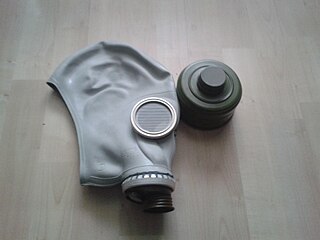
The GP-5 gas mask was historically used by the USSR for NBC protection. The mask has become a popular item in popular culture since and referenced widely in video games and films, as it is very cheap because it is the most produced gas mask ever. The GP-5 is a simple gas mask with protection around the entire head, and a single metal ringed filter for breathing. It was designed to protect against the ingress of toxic, radioactive substances and bacterial (biological) agents into the respiratory system, eyes and face of a person. It was produced in the period from 1961 to 1989. Taking into account the identified shortcomings in the operation of the civilian gas mask GP-5, it was modernized, which was called the modernized civilian gas mask model 5 - GP-5M. Gas masks GP-5 were produced three times more than the population of the Soviet Union. It was in impressive quantities in almost all industries and in civil defense shelters, sometimes it is still used as a training RPE in life safety classes, although now it is mostly replaced by the GP-7 and other soviet-era gas masks.
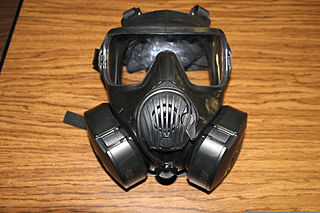
The M50 series protective mask consisting of the M50 and M51 variants, officially known as the Joint Service General Purpose (JSGPM) is a lightweight, protective mask system consisting of the mask, a mask carrier, and additional accessories. It was adopted by the U.S. military in 2006 and is manufactured by Avon Rubber.
Maurice Fernez was a French inventor and pioneer in the field of underwater breathing apparatus, respirators and gas masks. He was pivotal in the transition of diving from the tethered diving helmet and suit of the nineteenth century to the free diving with self-contained equipment of the twentieth century. All Fernez invented apparatus were surface-supplied but his inventions, especially his mouthpiece equipped with a one-way valve, inspired the scuba diving pioneer Yves le Prieur. He was also a talented businessman who created a company to manufacture and sell the breathing apparatus he invented, and expanded its range of products to include gas masks, respirators and filters.

The FM12 CBRN Respirator is a military gas mask produced by Avon Rubber.

The Interspiro DCSC is a semi-closed circuit nitrox rebreather manufactured by Interspiro of Sweden for military applications. Interspiro was formerly a division of AGA and has been manufacturing self-contained breathing apparatus for diving, firefighting and rescue applications since the 1950s.

An N95 filtering facepiece respirator, commonly abbreviated N95 respirator, is a particulate-filtering facepiece respirator that meets the U.S. National Institute for Occupational Safety and Health (NIOSH) N95 classification of air filtration, meaning that it filters at least 95% of airborne particles. This standard does not require that the respirator be resistant to oil; another standard, P95, adds that requirement. The N95 type is the most common particulate-filtering facepiece respirator. It is an example of a mechanical filter respirator, which provides protection against particulates but not against gases or vapors. An authentic N95 respirator is marked with the text "NIOSH" or the NIOSH logo, the filter class ("N95"), a "TC" approval number of the form XXX-XXXX, the approval number must be listed on the NIOSH Certified Equipment List (CEL) or the NIOSH Trusted-Source page, and it must have headbands instead of ear loops.
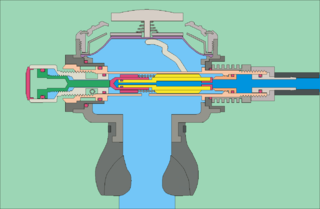
The mechanism of diving regulators is the arrangement of components and function of gas pressure regulators used in the systems which supply breathing gases for underwater diving. Both free-flow and demand regulators use mechanical feedback of the downstream pressure to control the opening of a valve which controls gas flow from the upstream, high-pressure side, to the downstream, low-pressure side of each stage. Flow capacity must be sufficient to allow the downstream pressure to be maintained at maximum demand, and sensitivity must be appropriate to deliver maximum required flow rate with a small variation in downstream pressure, and for a large variation in supply pressure, without instability of flow. Open circuit scuba regulators must also deliver against a variable ambient pressure. They must be robust and reliable, as they are life-support equipment which must function in the relatively hostile seawater environment, and the human interface must be comfortable over periods of several hours.

Mechanical filters are a class of filter for air-purifying respirators that mechanically stops particulates from reaching the wearer's nose and mouth. They come in multiple physical forms.
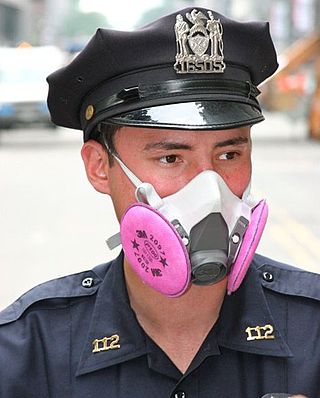
Elastomeric respirators, also called reusable air-purifying respirators, seal to the face with elastomeric material, which may be a natural or synthetic rubber. They are generally reusable. Full-face versions of elastomeric respirators seal better and protect the eyes.
















